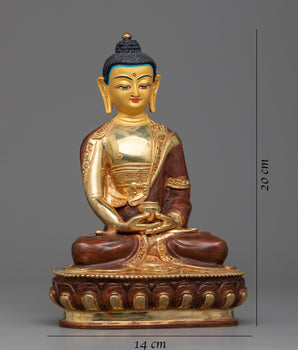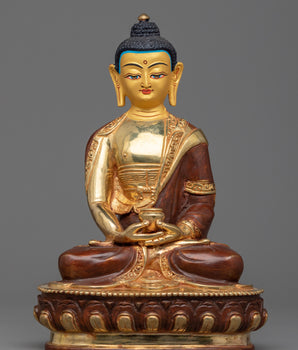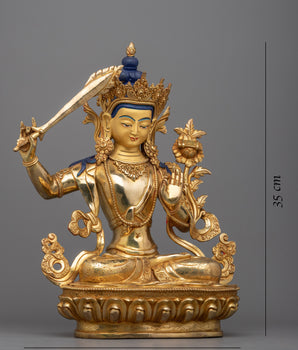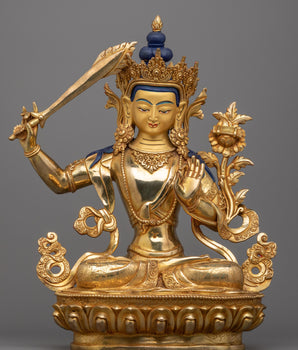A Sacred Medium for Mindfulness, Ritual, and Healing
Silver often stands for self-reflection in the spiritual world, bringing out inner purity reached through meditation and prayer. The beautiful iridescent look of jewelry has interested artists, monks, and spiritual people and has become a way to make items more appealing and highlight faith. In Asia and especially in the Himalayan regions, India, Tibet, and Southeast Asia, silver craftsmanship is now seen as a beautiful and spiritual art form. In Buddhism, silver represents a link between regular and spiritual life and is used to build objects needed for prayer, meditation, and to commemorate the wise. Experienced silversmiths design sacred geometry, special images, and mantras related to Buddhism.
Significance of Silver

Silver is treasured for its sparkling reflective quality, like the moon, which represents intuition, calmness, and the balance of nature. Because silver is believed to have these traits, it is commonly used in religious ceremonies aiming at protection and purification. In Buddhism, silver is clarity of mind, stillness, and mindfulness. It is well-suited for showing sacred images in meditation and ritual objects. The gentleness of silver shows itself in the soft, thoughtful way it reflects light. Silver’s physical traits, such as its antimicrobial and purifying nature, make it a strong spiritual symbol in Buddhism, similarly, the mind and body are cleaned in Buddhist beliefs. Since ancient times, people believed silver to be safe, which made it an important part of their religious ceremonies. Thus, silver is more than a commodity; for Buddhists, it stands for spiritual understanding, is seen as protecting, and is regarded as an expression of faithful practice, both actually and metaphorically.
The Origin and History of Silver Craftsmanship
Silver has been shaped by people into various forms for over 5,000 years and these items were involved in important religious and ceremonial activities. Its attractive features, including its reflective shine and workability, led people to make protection, healing, and ritual items.
In the 3rd century BCE, the rise of Buddhism made silver more important and gave rise to ritual items for meditation, making offerings, and holding ceremonies in temples. Every region created special styles, for example, India made refined repoussé and chasing, Nepal and Tibet perfected their detailed engraving, Thailand and Myanmar did high-relief silver with floral and religious art. Vietnam used brass to make detailed engravings. The traditions came down through artisan families who considered their work to be both art and a religious offering. To this day, silversmiths old and young use time-tested ways to make sacred items, carrying on the special mix of art and religious devotion.
Artisan Techniques: An Enjoyable and Thoughtful Activity

A sacred effect comes to silver only if an item is blessed with proper intention, not just by the artist’s talent. For many traditional silversmiths, making jewelry is almost a spiritual duty. Many of their approaches involve repetition, calmness, and are taught to other generations.
1. Repoussé & Chasing refer to hammering silver from both sides to make relief images, usually of gods, lotuses, or symbols.
2. Filigree Jewelry, thin silver threads are woven into endless, intricate shapes that represent the many links among individuals and their actions.
3. Mantras and special symbols are engraved into the metal, which is then inlaid with turquoise, coral, or gold to make jewelry both inspiring and beautiful.
4. Every item is both beautifully handmade and lovingly made with spiritual meaning in mind.
Spiritual Symbols Commonly Used in Silver Craft
Silver, which is seen as a sacred material, is often included in Buddhist and many spiritual rituals because of its reflections and spiritual significance. Symbols such as these, drawn from old religious traditions, evoke certain powerful energies, prompt practitioners to recall basic guidelines, and help them journey spiritually. Each of the Eight Auspicious Symbols (Ashtamangala) is thought to have its own religious and spiritual influence. Buddhist symbols such as the Dharma Wheel represent the teachings, the Lotus Flower spiritual awakening, the Endless Knot the interconnection of everything, and the Conch Shell shows how the teachings are spread. Vajra, which means thunderbolt, stands for unbreakable fact and spiritual strength.
Enhancing their spiritual powers, people often add inactive designs using engraving, embossing, or stones. How silver appears bright and reflective demonstrates to us how we can be aware of ourselves while realizing that all things in life pass away. Designing these symbols requires concentration or being mindful, and often people chant mantras during the process.
Silver in Buddhist Philosophy

The journey of Buddhist practice is often compared to that of silver. The tarnishing of the mirror in the story shows that when we are clouded by delusion, attachment, and ignorance, our minds are not clear. The gleam of silver symbolizes the chance to understand oneself, be more conscious, and find spiritual meaning.
In Buddhism, Enlightenment is when you realize your mind is bright and radiant. Because silver is soft, it stands for important Buddhist qualities such as compassion, gentleness, and the ability to be flexible. Working on silver items, especially in traditional ways, represents the process of inner purification. Silver, resembling a mirror, is usually connected to the way the mind helps us understand things and cultivate wisdom and kindness. Interaction with silver leads people toward wisdom, kindness, and spiritual growth.
Healing and Energetic Properties of Silver in Spiritual Practice
Spiritual traditions reverence silver for its ability to heal and enhance energy. Because it is believed to hold spiritual energy, it is commonly used in sacred tools and jewelry. Some holistic health practitioners use silver for its purifying and restorative advantages, and it is also used in modern alternative medicine and energy healing.
Energy Conduction: Because silver can be so effective in both health and ritual, it is often valued for use in spiritual tools.
Purification and Protection: Silver is often recommended by spiritual healers for its reputation to stop negative energy and support a sense of calm and focus for the mind and emotions.
Traditional Healing Methods: Across the world, silver has been used to heal wounds, stop diseases, and keep the body’s internal balance. Both Ayurveda and Tibetan medicine hold that silver dishes and containers of water improve strength and reduce mental stress.
Spiritual Beliefs: Nowadays, crystal workers often add silver jewelry or metallic tools to their practice, as this amplifies the positive effects of other gemstones such as turquoise, moonstone, or quartz, particularly when they meditate or work on chakra balancing.
Buddhist Practices Involving Silver Ritual Objects

Silver is admired in Buddhism, especially in Tibet, Nepal, Bhutan, and various places in India, for carrying special energy and value. Practitioners in all groups use silver to help in their spiritual practices, connect with more advanced teaching, and show reverence.
1. Offering Bowls made of silver
Offering bowls made of silver are often placed in a row in front of a shrine or sacred statue at Tibetan and Vajrayana Buddhist temples. Each bowl displays one of the Seven Offerings: drinking water, water for washing up, flowers, incense, a light, perfume, and food. Filling the receptacles with silver makes the intention even purer, and this act gradually becomes a mindful meditation.
2. Silver Stupas and Relic Holders
In Tibetan craftsmanship, it is common to find miniature chorten, used to keep and protect relics, relic ashes of a lama, or even small holy books. Reflective metal is in Buddhism a symbol of clear thought and bright wisdom, which are key aspects of the religion’s objectives.
3. Ritual implements: Vajra, a bell, and Phurba

Ritual gadgets like the vajra (dorje) and bell (ghanta) are made from silver and often decorated with turquoise or coral. The vajra stands for truth that is unbreakable, and the bell stands for wisdom and nothingness. During rituals and initiations, people view these items as very meaningful spiritual tools. Phurbas, which are used in Tantric rituals, are made with silver. Using it helps clear up certain bad energy, and it makes people more aware.
4. Silver statues and Bodhisattva images
Often, statues of Buddhas and Bodhisattvas, especially Chenrezig (Avalokiteshvara), Tara, or Medicine Buddha, are molded from pure or gilded silver. Gentleness, compassion, and clarity are the features represented by silver here, which are also the qualities of these gods.
4 Best Ways to Keep Silver from Tarnishing

Silver is a classic metal, although it must be looked after to avoid it becoming dull. Follow these four guidelines to make sure that your silver jewelry, utensils, or decorations keep their attractive color and luster.
- Store away from Moisture: Avoid exposing your silver to a humid environment.
- Anti-Tarnish Materials: Keep silver safe from tarnishing by wrapping it in anti-tarnish fabric or adding silica gel or anti-tarnish strips to the storage box.
- Contact with Chemicals: Always keep silver clear from perfumes, lotions, and cleaning materials.
- Clean Gently: Wipe with a Soft Cloth and Silver Cleaner to Maintain Your Silverware.
Conclusion
Silver craftsmanship goes much deeper than being a decorative art; it is based on believing, respecting, and valuing sacred intentions. As silversmiths in the Himalayan regions and other parts of Asia make them, every piece represents truthfulness, kindness, and one’s spiritual quest. Of all metals, silver’s softness, pureness, and reflectiveness most individually represent the ideals of Buddhism and the process to reach them in life.
When used to make ritual equipment, statues for worship, or jewelry, silver links the physical world to the spiritual world. Maintaining older methods and experience, artists still hold on to a respected background in which feelings are turned into art. Looking after silver as the artisans did in creating it helps us value both its appearance and its symbolism. Silver softly tells us that we each have knowledge inside us and that learning takes time to perfect.














